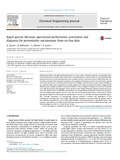JavaScript is disabled for your browser. Some features of this site may not work without it.
| dc.contributor.author | Upton, Andrew | |
| dc.contributor.author | Jefferson, Bruce | |
| dc.contributor.author | Jarvis, Peter | |
| dc.date.accessioned | 2017-02-13T16:40:47Z | |
| dc.date.available | 2017-02-13T16:40:47Z | |
| dc.date.issued | 2016-12-16 | |
| dc.identifier.citation | A. Upton, B. Jefferson, G. Moore, P. Jarvis, Rapid gravity filtration operational performance assessment and diagnosis for preventative maintenance from on-line data. Chemical Engineering Journal, Volume 313, 1 April 2017, pp. 250-260 | en_UK |
| dc.identifier.issn | 1385-8947 | |
| dc.identifier.uri | http://dx.doi.org/10.1016/j.cej.2016.12.047 | |
| dc.identifier.uri | http://dspace.lib.cranfield.ac.uk/handle/1826/11440 | |
| dc.description.abstract | Rapid gravity filters, the final particulate barrier in many water treatment systems, are typically monitored using on-line turbidity, flow and head loss instrumentation. Current metrics for assessing filtration performance from on-line turbidity data were critically assessed and observed not to effectively and consistently summarise the important properties of a turbidity distribution and the associated water quality risk. In the absence of a consistent risk function for turbidity in treated water, using on-line turbidity as an indicative rather than a quantitative variable appears to be more practical. Best practice suggests that filtered water turbidity should be maintained below 0.1 NTU, at higher turbidity we can be less confident of an effective particle and pathogen barrier. Based on this simple distinction filtration performance has been described in terms of reliability and resilience by characterising the likelihood, frequency and duration of turbidity spikes greater than 0.1 NTU. This view of filtration performance is then used to frame operational diagnosis of unsatisfactory performance in terms of a machine learning classification problem. Through calculation of operationally relevant predictor variables and application of the Classification and Regression Tree (CART) algorithm the conditions associated with the greatest risk of poor filtration performance can be effectively modelled and communicated in operational terms. This provides a method for an evidence based decision support which can be used to efficiently manage individual pathogen barriers in a multi-barrier system. | en_UK |
| dc.language.iso | en | en_UK |
| dc.publisher | Elsevier | en_UK |
| dc.rights | Attribution 4.0 International | |
| dc.rights.uri | http://creativecommons.org/licenses/by/4.0/ | |
| dc.subject | Filtration | en_UK |
| dc.subject | CART | en_UK |
| dc.subject | Turbidity | en_UK |
| dc.subject | Fault diagnosis | en_UK |
| dc.title | Rapid gravity filtration operational performance assessment and diagnosis for preventative maintenance from on-line data | en_UK |
| dc.type | Article | en_UK |
| dc.identifier.cris | 16345768 |
Files in this item
This item appears in the following Collection(s)
-
Staff publications (SWEE) [2815]

